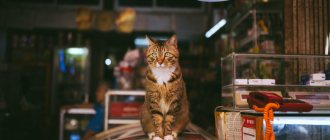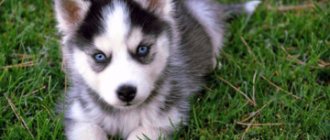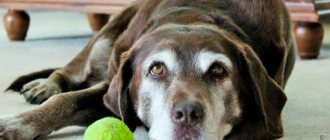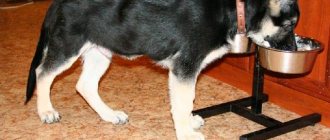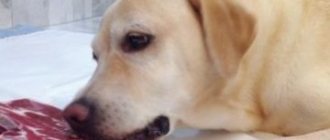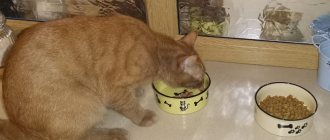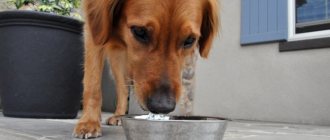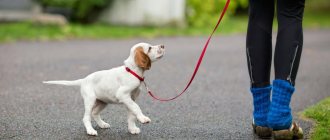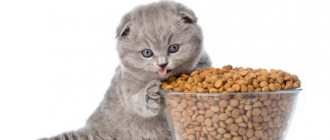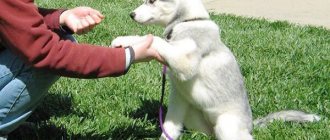The Siberian Husky is a breed that emerged in the harsh conditions of the north. It was intended to help people transport goods and as a sled dog. Today, Khasenysh are kept as companions, although in the Far North they still remain working dogs. To raise a healthy, physically developed animal, you need to know what to feed your husky puppy, what is preferable to include in the menu, and what foods are contraindicated for feeding. Since hyperactivity, endurance and the ability to withstand severe frosts are a distinctive feature of the breed, the diet must be treated very responsibly so that feeding errors do not become fatal.
What to feed a husky puppy
There are three types of feeding for husky puppies:
- natural;
- industrial;
- mixed.
Each of them has its pros and cons. The best option is natural feeding, which is also the most natural. Porridge, meat, vegetables, eggs, and fermented milk products can be combined and feed your pets varied and tasty. Depending on the age, condition, needs of the puppy, time of year and rate of weight gain, the diet is adjusted. The disadvantages of “natural food” are that it will take a lot of time to prepare, and if the menu is incorrectly compiled, you will also have to feed the puppies vitamins and minerals.
When choosing industrial feed, they focus on the highest quality - premium, super-premium or holistic. The choice of dry granules and canned food is quite wide, dosing and feeding them is simple and convenient, but the price of the best food is quite high.
The puppy is breastfed until four to five weeks, after which it is gradually transferred to an adult diet.
At 1 month
At 4-5 weeks, the Husky puppy opens its eyes and begins to show interest in adult food. It can be natural or industrial. At this age, Hasyats are fed infant formula or whole milk, cottage cheese and kefir. Puppies digest well boiled egg yolk, cooked minced beef, and low-fat broth.
It is impossible to feed a 1-month and 1.5-month husky with pellets at this age. When choosing ready-made food, preference is given to pates that correspond to the age of the puppies.
At 2 months
A 2-month-old little husky's diet is even closer to that of an adult since it has a full set of teeth. Raw meat is included in the diet. It is frozen for 3-4 days, after which it is thawed and crushed. If you are not sure that it is unsafe to feed it to a two-month-old puppy, pour boiling water over it.
When choosing an industrial type of feeding, huskies are given meat pieces with gravy.
At 3 months
At three months of age, vegetables should make up up to 50% of a husky puppy’s diet. They are given in the morning along with egg yolk and fermented milk products. At lunch they feed meat or fish, in the evening - porridge. As a snack - cottage cheese. With the industrial type of feeding, granules are used for small puppies. They are pre-soaked in milk or broth.
At 4 months
During the period of teeth change, the diet of a 4-month-old husky puppy should be rich in vitamins and microelements. If they are deficient, the Khasenysh’s teeth are delayed. To prevent your ears from falling off, you need to feed him cottage cheese and kefir more often to replenish the lack of calcium in the body.
Feeding with industrial granules continues in the same form as before (pre-soaking). “Drying” is combined with canned food and milk substitutes (once a day).
At 5 months
At 5 months of age, a Husky puppy begins to be fed offal. Tripe, liver, trimmings are crushed and frozen. Tripe is given weekly, and the yolk of a boiled egg is added to food twice a week. If a dog is undergoing a general training course, then the treat that is offered as a reward is counted as one meal in the dog’s diet.
When fed dry food, the puppies are gradually transferred to food marked “Junior”. Do not forget about constant access to clean, fresh water.
At 6-9 months.
After changing teeth to permanent ones, the Husky puppy's diet is significantly varied. It can be fed with vegetables, fruits and offal. The range of cereals is being expanded.
Production granules are selected taking into account their composition (with a reduced amount of proteins).
At 10 and 11 months
As dogs grow older, they reduce the frequency of feedings, while increasing the size of portions. The feeding regimen for huskies from 10 months to a year involves three meals a day, consisting of meat products (33%), cereals (33%) and vegetables (33%). 1% leaves vitamins, oil and herbs.
When feeding ready-made industrial products, youngsters are given granules (according to age) and canned food. The first component should account for 75% of the diet, the second – 25%.
At 1 year
Once a husky becomes an adult dog, he no longer needs the abundance of vitamins necessary for the development of a puppy. The diet should contain:
- meat (turkey, lean beef, veal);
- vegetables (carrots, beets, cucumbers, cabbage);
- sea fish (after heat treatment);
- offal;
- cereals;
- dairy products.
Sensible Nutrition hypoallergenic food from Happy Dog or Fit&Well is a good choice for an adult one-year-old pet. Royal Canin's Medium Adalt formula is ideal for huskies. It is permissible to dilute a dry diet with wet canned food from the same manufacturers.
Feed rating
Food for a puppy of this breed should be at least premium class.
When choosing a suitable diet, you must carefully study its composition.:
- the first place in the list of ingredients should be meat (food based on beef, chicken, lamb is suitable for puppies) or fish, indicating their type;
- Vitamin E should be used as a preservative;
- The composition must be free of flavors, dyes and preservatives and contain proteins.
The most suitable food for husky puppies:
- Acana Puppy and Junior - made from fresh meat and fish, contains cereals, vegetables, fruits, oats with a low glycemic index and additives that promote the proper formation of bone tissue;
- Orijen Puppy – contains no grains, but contains more than 75% meat components, a small amount of carbohydrates, vegetables, beans, berries, fruits and special minerals and vitamins;
- Almo Nature Medium Puppy - 53% consists of meat ingredients, contains cereals and plant components, and rosemary extract is a natural antioxidant;
- Nutra Gold - contains meat or fish fillet, grains, legumes, vegetables, algae, vitamins, minerals, microelements; there are no flavor enhancers, flavors or other artificial additives;
- Royal Canin (Medium Puppy) – contains at least 30% meat; for puppies of this breed, you should choose holistic food with hypoallergenic ingredients;
- Advance - food consists of more than 22 products and contains at least 15% meat, enriched with essential microelements;
- Purina Pro Plan – containing at least 20% meat and offal, the Medium Puppy Sensitive line is suitable for medium breed puppies prone to allergies;
- Happy Dog (Medium Baby) – contains about 25% meat, plant extracts, fermented cereals, flax seed, fatty acids, micro- and macroelements, no dyes, preservatives, soy.
Also suitable for feeding puppies of this breed are 1st Choise (Puppy series), Now Fresh (Puppy Chiot) and Josera Puppy..
Huskies should not be fed low-quality economy class products.
How many times a day should you feed your Siberian Husky puppy?
Huskies are a breed with an average appetite, although many breeders consider them to be small dogs. This circumstance should not be alarming, since by their nature hound dogs are designed for hard physical work, so they need a small amount of food per day. In the summer, when the air temperature is above +20 ⁰C, the Khasenys are given fasting or drinking days.
You should follow the recommendations of veterinarians regarding how many times a day to feed your cat:
- At 1 month - puppies eat 4 to 6 times a day with a break for night sleep.
- At 2 months, the frequency depends on the growth rate of the puppy, on average 4-5 times.
- At 3 months, they are fed 3-4 times (depending on the size of the Khasenys), including snacks.
- At 6 months, the portions are increased and food is given 3 times a day.
- From 10 to 12 months, the pet is transferred to adult food twice a day.
Where do you start with the first complementary feeding?
You need to start feeding puppies 3-4 weeks after their birth. At this age, babies need additional sources of energy, vitamins and minerals, which is due to active growth and formation of the body.
IMPORTANT!
Milk porridge, calcined cottage cheese, meat broths, and grated boiled carrots are used as complementary foods.
All food should be liquid or mushy and at room temperature or slightly warmer. If the puppy reacts negatively to some complementary foods, they should be eliminated and the portion reduced.
If for some reason the bitch cannot feed the puppies or her milk is not enough, the babies need to be fed earlier, using bitch milk substitutes.
Natural or dry food - which is better for puppies?
The dog breeder must choose the type of feeding in advance - natural products or “drying”. Choosing the first option has its pros and cons.
The benefits of natural nutrition include:
- the opportunity to take into account the wishes of the pet;
- the owner knows exactly the composition of the dish for the hasyat;
- Synthetic dyes, preservatives and flavor enhancers are not used as ingredients.
There are also disadvantages:
- after heat treatment, products lose some of their beneficial properties;
- it takes time to cook;
- it is difficult to travel with this type of feeding;
- additional enrichment of food with vitamin supplements is necessary.
The use of dry feed mixtures has its advantages:
- ease of feeding;
- diversity of composition;
- balanced and nutritious diet;
- wide range of feeds.
The negative aspects of “drying” include:
- inability to accurately determine the composition;
- high salt, soy or low quality products in cheap feed mixtures;
- the presence of chemical preservatives or dyes.
The owner of a husky puppy decides what type of feeding to choose. He is guided by the pet’s preferences, his condition, and his capabilities.
Industrial feed
This type of dog nutrition is popular among many breeders . But, before choosing it for your pet, you need to study its pros and cons and understand how to choose the right food.
Advantages and disadvantages
Like natural nutrition, a diet based on industrial feed has a number of advantages, but is not without its disadvantages.
The advantages include:
- balanced composition, enriched with vitamins and minerals;
- the ability to buy food for future use;
- simplicity and ease of use;
- the presence on the packaging of information about the daily consumption rate;
- saving time and effort on cooking and planning a diet;
- an assortment that allows you to choose food taking into account the age of the puppy.
In addition, the special composition with which the dry food granules are coated helps clean the husky’s teeth.
Disadvantages of industrial feeds:
- lack of liquid in food, unless we are talking about wet food;
- the possibility of using low-quality meat and meat waste to make feed;
- the likelihood of containing chemical flavors, dyes, flavor enhancers, soy and other harmful components;
- high cost for quality products.
If your puppy develops an allergy to one of the components of the food, the entire diet will have to be changed..
Dry or wet
Wet food contains up to 80% liquid, so it is healthier for your pet's stomach, but less nutritious.
CAREFULLY!
Such products cannot be stored for a long time - the shelf life of opened pates and canned food is no more than 2 days.
The best option for using wet food is mixing it with dry food . It is important that they be of the same brand and belong to the same class of feed.
Mixed diet
Some dog breeders prefer mixed feeding - ready-made food and natural products. Experienced breeders and veterinarians do not recommend this method for several reasons:
- it takes different times to digest “dry” and “natural” food, so one part of the food rots while the other is already evacuated from the stomach;
- Dysbacteriosis develops - beneficial bacteria die and are replaced by pathogenic ones;
- mixed feeding is dangerous both due to a lack of vitamins and hypervitaminosis;
- extra calories lead to obesity;
- an allergic reaction, disruption of metabolic processes, the functioning of blood vessels and the heart are possible.
How to care for a husky? Basic Rules
When getting a Husky, you should remember that these dogs are very active and sociable, they feel bad without the attention of their owners. Representatives of this breed are not recommended for people who do not have the opportunity to spend a lot of time with their pet.
Being at home alone for a long time, a husky can seriously damage the furniture in the apartment, your clothes and shoes, as well as wires. In addition, the dog may begin to howl loudly. An important condition for this breed to live are long walks, which include exercises aimed at releasing the accumulated energy in the animal. On average, it is recommended to walk these dogs for at least 1.5–2 hours twice a day.
Other important care procedures are:
- Combing. To avoid tangles and hair loss, you need to brush the hair regularly. This needs to be done 1-2 times a week; during molting they do it more often, almost daily.
- Bathing and washing. This is a clean breed, and the Husky's coat is capable of self-cleaning. However, the dog still needs to be bathed using dog shampoo, but this does not need to be done often - once every 2 months or quarter is enough.
- Trimming nails. This procedure is necessary if the dog’s nails do not wear down during walks. They should be trimmed carefully so as not to damage the capillaries located in the claws. The resulting sharp edge must be filed to prevent the claw from splitting.
- Cleaning teeth and ears. Teeth brushing, like for humans, is necessary every day using a special paste and brush for dogs - this will avoid the accumulation of plaque and the formation of tartar, which is fraught with more serious health problems. The ears are cleaned with a cotton pad soaked in a special lotion.
- Rubbing the eyes. Gently use a cotton pad to remove dirt from your eyes. Remember, this breed is genetically susceptible to eye diseases and proper care is of great importance in preventing diseases. Additionally, you can use eye drops, but you need to select them together with your veterinarian.
You should also not forget about the vaccinations required for all dogs and regular treatment of your four-legged friend against ticks, fleas and helminths.
How much food to feed a husky puppy?
The amount of natural food you should feed your husky depends on its weight. Until six months of age, the volume should be 5-7% of the puppy’s weight. 50% of the daily intake comes from meat and offal, 10% from cottage cheese and kefir, 30% from porridge and 10% from vegetables.
After six months, the daily ration is 3.5% of the Khasenysh’s weight.
To determine the norm of dry food, use the table indicated on the packaging. It is gradually adjusted depending on the activity, appetite and age of the dog.
When should you start feeding puppies and with what? It's week 3, there are 5 puppies in the litter. Chihuahua.
COMPLEMENTARY FEEDING CAN BE STARTED FROM THE THIRD WEEK. SOAKED DRY FOOD OR SCRAPPED MEAT. IT IS BETTER TO INTRODUCE COMPLEMENTARY FEEDINGS GRADUALLY IN VERY SMALL PORTIONS AT NIGHT. FROM MILK THE BEST IS GOAT'S MILK WARM, COLD WILL NOT BRING ANY BENEFIT. AFTER A MONTH YOU CAN ALSO GIVE CHILDREN'S COOK OR MAKE COOK YOURSELF. INTRODUCE ONLY ONE PRODUCT AT A TIME, LET'S SET MEAT FIRST AND WHEN THE CHILDREN ALREADY EAT MEAT WELL. THEN DRY THE FOLLOWING STAGE MEAT + DRYING AND GRADUALLY ADD COOK OR YOGURT. IN THE RESULT, YOU HAVE MEAT + DRYING + COOK ETC. AND DON'T FORGET TO LET THE CHILDREN SUCK THE MOM.
If children have enough milk and are gaining normally, then there is no need to give children anything before 21 days. Until three weeks of age, puppies' gastrointestinal tract does not function fully; there are not enough enzymes necessary to digest anything other than mother's milk. At three weeks it is necessary to drive away worms for both puppies and mother, do not forget about this. And at 3 weeks you can start feeding from a bowl. I first offer my puppies natural unsweetened yogurt, heat it to about 38 degrees, you can do it in the microwave (it’s enough to turn it on for 10 seconds), or you can put a glass of yogurt in a cup of hot water. The bowl should be very flat, you can use a regular jar lid to start with. At first, children may not understand that they need to eat this; you can dip your finger in the yogurt and apply it to your lips with your finger; as a rule, they begin to lick both their lips and finger and then begin to eat from the bowl. After a couple of days, I start giving raw heart (any kind) by turning it in a blender. When they start to eat more or less normally, I start adding a little grated carrot and an apple to the heart. Instead of yogurt, you can then give kefir, cottage cheese, diluted with milk in a thinner form that is convenient for them to lap up.
If you feed your mother dry
Source
Menu for a puppy for a week
Huskies need to be fed high-calorie foods. Only in this case will the dog grow up strong and healthy.
A sample weekly menu looks like this:
| Monday |
|
| Tuesday |
|
| Wednesday |
|
| Thursday |
|
| Friday |
|
| Saturday |
|
| Sunday |
|
Husky recipes
Meat porridge (2 servings)
For 500 - 600 grams of beef trim, pour 13 cups of porridge (buckwheat or rice) with water. After boiling, add grated carrots, finely chopped cabbage or zucchini, and bay leaf. Add a little salt. No seasonings can be added.
Chicken porridge (4 servings)
Pour 1 kg of chicken legs with water and cook until half cooked, add half a glass of rice, grated carrots, finely chopped onion, bay leaf. Cook until the rice is ready.
Oatmeal
There is no need to cook the flakes, pour in hot broth (meat or vegetable), cover with a lid and let sit for 30 minutes. Add half a teaspoon of butter or sunflower oil.
Calcined curd
For 1 liter of boiling milk, add 3 - 4 tablespoons of a 10% calcium chloride solution (sold at the pharmacy). Place on a sieve and strain. Cottage cheese is served warm to the puppy; it is an excellent remedy for the prevention of rickets.
There are no special requirements for bowls; they must always be clean, just like for food and water. Change your dog's water every day. True, puppies love to play, so fragile ceramic, plastic, porcelain or glass will not work. Metal utensils work well. The four-legged friend will not chew it or break it.
Huskies just need to be loved. In caring hands, obedient, affectionate and cheerful dogs grow up.
How to cook food for Khasenysh?
To feed your pets correctly, you need to know how to prepare food. Several recommendations should be followed:
- The meat is thawed for 72 hours, then cut into small pieces and fed to the dogs.
- Seafood is boiled.
- The cereals are poured with hot water and left for 30 minutes.
- Add a little oil to the porridge and add a little salt.
- Eggs are boiled and given without protein.
- Vegetables are steamed.
- Cucumbers and tomatoes are fed raw.
- The offal is washed several times and then boiled for 2 hours.
First days at home
Raising and caring for husky puppies can be carried out by all family members, but the person who spends the most time with the pet will have the greatest authority.
Joint walks, classes and trips to exhibitions help strengthen affection; the dog begins to sense the owner’s mood and understand him without words.
Husky puppies easily settle into a new place and are well suited for apartment living.
From the first days, the baby should have his own place to sleep, a cage to isolate the pet while he is away, and two bowls.
Most often, a sleeping mat is placed in a cage, creating a kind of cozy house, and toys are also placed there.
The cage door is left open when there is someone at home so that the baby can move freely.
If the puppy is left alone, the cage is closed. You can also build a pet booth .
The article i/ will tell you how you can insulate it for the winter.
Advice! It is advisable that during the first month in the new home, the puppy is left alone as little as possible. It is at this time that the foundations of neatness and establishing contact with the owner are laid.
An unexpected encounter between a husky cub and a white lion cub in New York's Central Park
Huskies, like shorthaired pointer puppies , are very active, but the little puppy sleeps a lot, and after each awakening he must be picked up and taken outside to recover.
In order for the baby to quickly develop the skill of asking to go outside, he is taken out as often as possible: after eating, resting, playing.
You can read more about how to train your dog to use the toilet outdoors here:
You should immediately prohibit your pet from doing anything that would be inappropriate in the behavior of an adult dog.
You cannot climb on upholstered furniture, jump on the owner, or beg at the table.
A cute baby who plays such funny pranks quickly turns into a large, ill-mannered dog, annoying and disturbing everyone.
Husky puppies have a tendency to run away from childhood
Vitamins and supplements in the diet of Khasenyshes
During the period of active growth of animals and the replacement of their teeth with permanent ones, the animal’s body needs vitamins and mineral supplements. A veterinarian can recommend ready-made complexes that can be purchased at a pharmacy, and he will also prescribe the required dose and procedure for taking the medications.
The lack of vitamins can be compensated with the help of feed additives:
- Tricalcium phosphate – eliminates the imbalance of calcium and phosphorus.
- Omega-3 and omega-6 – for the production of vitamins A and D.
- Brewer's yeast – enhances the body's protective functions.
- Bran is a source of fiber.
Natural food
When developing a menu for a husky puppy, you need to take into account the dog's need for proteins and fiber, which will allow the intestines to function properly. Amino acids, micro- and macroelements, vitamins are important.
Must-have products for a husky puppy
- Meat. This is the main supplier of proteins, its amount should be at least 70% of the daily food volume. Huskies are not allowed to eat fatty meats such as lamb or pigs. Preference should be given to beef, chicken, venison, and turkey;
- Offal. These are the internal organs of animals: lungs, heart, trachea, liver, spleen. This food consists of microelements and vitamins required by the puppy’s body. Tripe has enormous benefits: it is important to add it to the food of huskies, especially young ones. It is necessary to give by-products quite regularly, but not daily, so as not to cause hypervitaminosis;
- Bones. They should not be considered food, but sometimes you should pamper your puppy with a large bone: this will make it possible to strengthen the jaw muscles, clean the teeth, and avoid caries. Such bones should be given to puppies before teeth change - in adulthood, bones can harm the teeth and stomach of animals;
- Cartilage for a husky puppy plays an important role in its physical development.
Cartilage is a supplier of collagen, microelements, and vitamins that play an important role in the proper formation of the body. It is more beneficial to give along with leftover meat; - Fish. Huskies are only allowed to feed fish that have grown in the sea. It contains many useful elements: iodine, fluorine, amino acids, phosphorus and so on. In addition, sea fish is rich in vitamins A, B, D, so it must be included in the husky’s diet;
- Porridge. Huskies are fed only three types of cereals: rice, oatmeal and buckwheat. It is necessary to feed your puppy porridge because it helps normalize intestinal function. Porridges make up about 10% of the daily amount of food;
- Dairy products. They contain calcium, which is an essential building material for the musculoskeletal system. Puppies of this breed can only be given low-fat products: zero-fat kefir and cottage cheese, the fat content of which does not exceed 10%. All products must be fresh. They are given in the morning, almost completely replacing other foods;
- Egg. No more than twice a week you should give your puppy a chicken egg yolk or a whole quail egg;
- Vegetables. Contains many minerals and vitamins. Cabbage is especially important because it stabilizes digestion. It is important to give tomatoes, zucchini, carrots, beans and pumpkin;
- Vitamin complex. They should be purchased only after consultation with a veterinarian.
Huskies love sweets very much, so you can pamper them with banana, honey or dried apricots. Baking and sweets are prohibited for dogs.
Foods prohibited for husky puppies
Husky puppies are not allowed to eat chicken bones.
Not all foods can be given to puppies of this breed. You should consider the list of those that are prohibited for these animals:
- fatty meat, chicken and veal;
- milk;
- boiled bones, chicken bones;
- chicken egg white;
- chocolate and any sweets;
- grapes, raisins;
- nutmeg;
- potato;
- a large number of tomatoes (you are allowed to eat a little to avoid allergies);
- sugar substitutes;
- smoked, salted, fried, pickled, spicy foods;
- hot/cold food;
- vitamins for people;
- products containing large amounts of dyes, preservatives, and flavorings.
Prohibited foods in the diet
Owners of northern dogs should know what foods they should absolutely not feed:
- Chocolate contributes to the development of diabetes and problems with the cardiovascular system. Consumption in excess amounts is fatal.
- Boiled tubular bones have no nutritional value, but can form sharp fragments that can cause injury to internal organs.
- Sugar contributes to obesity, damages tooth enamel, and worsens skin condition.
- Candied fruits, grapes, citrus fruits - cause flatulence and colic.
- Smoked, pickled, salted foods cause damage to the liver and kidneys.
- Pork and lamb are harmful to the pancreas.
- Seasonings and spices - destroy the mucous membrane of the stomach and intestines.
- Whole milk - after six months, dogs do not produce enzymes to digest it, consumption causes indigestion and allergies.
What can and cannot be given
You should not pamper your animal with food from the owner's table. Having shown his weakness once, the owner will always watch the beggar in front of him. In addition, human food can lead to constipation, flatulence and other problems with the pet's gastrointestinal tract. Housewives are accustomed to pampering their household members with delicious dishes. Pets can also target treats. Even if the owner’s heart skips a beat, you should not give the animal different types of goodies, as they will have a bad effect on its health.
So, Husky dogs are prohibited from:
- confectionery;
- canned food;
- smoked products;
- fried food;
- salty and spicy dishes;
- seasonings
But the things that can cause the most harm to an animal are: chocolate, sweets and grapes. They are very dangerous for the dog’s health; after consuming them, allergic reactions and skin rashes can immediately begin. In rare cases, these foods can even lead to the death of a pet.
Interestingly, Husky dogs cannot chew. The explanation is simple - they lack chewing teeth. For this reason, it is forbidden to give minced meat to Siberians. Otherwise, your pet may experience problems with its digestive system.
General recommendations for healthy feeding at home
Proper nutrition is one of the main components of healthy growth and development of a dog.
To eliminate possible mistakes regarding feeding your pet, you must follow several recommendations:
- the diet should consist of 70% dietary meat;
- you need to give your dog both boiled and raw vegetables;
- approximately 10% of the diet consists of cereals such as rice and buckwheat;
- Adult dogs should not be given milk, but fermented milk products are necessary to ensure proper functioning of the gastrointestinal tract;
- Do not feed your husky food too cold or hot;
- It is prohibited to mix industrial feed and natural products;
- all food must be fresh, prepared from high quality products;
- it is important to follow the feeding regime;
- with a natural diet, it is necessary to give your pet additional vitamins and minerals;
- The dog should always have drinking water freely available.
You should not feed your dog before bedtime, walks or trips in public transport or a car . The bowl of food should be left for 20-30 minutes, after which it should be removed, even if the dog has not eaten everything.
It is necessary to ensure that the pet receives vitamins A, E, C, D, B, K, PP, calcium, copper, iron, iodine, zinc, as well as glucosamine, collagen, chondroitin and polyunsaturated acids.
Transfer to another type of feed
As already mentioned, simultaneous consumption of several types of feed is undesirable. This is true. However, there is an exception - a situation when the puppy needs to be switched to a different food altogether (for example, from natural to dry food or vice versa, or to a different brand of dry food).
In this case, the potential harm from the abrupt switch exceeds the potential benefit from not mixing. The dog needs to be switched to a new diet gradually.
This is done simply: little by little you begin to add new food to the old, day by day increasing the percentage of new food in the mixture. Little by little, the old food will be replaced, and the pet’s body will get used to the new composition. Typically, the entire procedure takes about two weeks.
This is important knowledge. Most likely, it will be needed in the first weeks of the puppy’s with you: most husky admit that they did not use the food provided by the breeder, but developed their own nutrition . The skill of switching to a new diet can come in handy more than once during a dog’s life, but it’s still better if you use it infrequently.
How to tell if your puppy is eating normally
There are two main indicators of health:
- appearance;
- well-being.
During the examination, the veterinarian visually assesses the condition of the puppy and collects an anamnesis, that is, interviews the owner about how the animal has felt and behaved recently. Of course, the doctor knows the nuances that a common person may not know. However, an attentive dog breeder can create a checklist and evaluate the animal’s condition based on it.
You need to regularly pay attention to the following details:
- the appearance of the puppy’s - it should be neat, not greasy, moderately shiny, without bald spots (the first shedding of a husky occurs closer to the age of one, so tufts that can be plucked out by hand are a sign that he is not being fed );
- discharge from the nose, ears, eyes (normally there should be no discharge, with the exception of small natural contaminants - for example, accumulations of earwax);
- the pet’s mood (a healthy husky puppy is active, inquisitive, keenly interested in the world around him, you and food );
- appetite (if the dog refuses to eat, this is an alarming symptom);
- condition.
Let's take a closer look at the last point. Carefully examine the puppy's body in profile and from above. Normally, a Siberian Husky puppy should have a lean build - this is a sign that you are feeding him correctly . The ribs of a healthy little husky can be easily felt, but are covered with a layer of fat. Despite this, when viewed from above from the back, the waist is visible behind the ribs, and the stomach is tucked from below.
Insufficient visibility of curves (waist, abdomen) and a dense layer of fat on the sides indicate that the puppy is overweight. On the contrary, if the bones are noticeable even from a distance (for example, the tops of the vertebrae in the lumbar part of the body are clearly visible), then the puppy is clearly malnourished.
Feeding small huskies correctly is very important - it is even more responsible than preparing a diet for a junior puppy or an adult animal. During the first months after birth, all systems of the child’s body are actively developing, “being built”—the foundation for the future is being laid. How healthy and nutritious a puppy eats largely determines its health for the rest of its life.
Changing your diet
Various situations may arise when this may be required, but, in any case, the transition must be made as gentle as possible.
Method of changing dry to natural type
- Make the change gradually over a two-week period;
- Natural fertilizer should never be given at the same time as dry food, distributed in the morning and evening;
- Slowly increase new menu components (for the first 7-10 days they can only be added for breakfast);
- Closely monitor the general well-being of your pet (behavior, stool).
Reverse type change method
Basically the principles are the same:
- Smooth transition over a two-week period;
- Do not mix different types of feed;
- Increase the total share little by little;
- Monitor the condition of the gastrointestinal tract;
- Ensure adequate fluid availability.
Translation can cause diarrhea, constipation, incomplete digestion; if such problems arise, you can consult a veterinarian about the choice of prebiotics.
We take into account the characteristics of the breed
First of all, you need to take into account that huskies have a very sensitive stomach. Therefore, you can safely choose food marked “hypoallergenic”. Individual options made from lamb or fish would be an excellent choice. But chicken requires an individual approach, since it is considered an allergenic meat. Even if a certain product has been highly advertised to you, you need to carefully read the label. The presence of soy, corn and dyes, as well as unknown and unfamiliar additives, is another reason to refuse the purchase. This food will not bring anything good to your dog.
